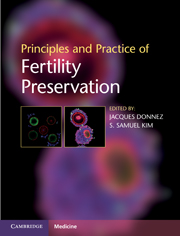Crossref Citations
This Book has been
cited by the following publications. This list is generated based on data provided by Crossref.
Di Paola, Rossana
Costantini, Claudio
Tecchio, Cristina
Salvagno, Gian Luca
Montemezzi, Rachele
Perandini, Alessio
Pizzolo, Giovanni
Zaffagnini, Stefano
and
Franchi, Massimo
2013.
Anti-Müllerian Hormone and Antral Follicle Count Reveal a Late Impairment of Ovarian Reserve in Patients Undergoing Low-Gonadotoxic Regimens for Hematological Malignancies.
The Oncologist,
Vol. 18,
Issue. 12,
p.
1307.
Martinez, Francisca
2017.
Update on fertility preservation from the Barcelona International Society for Fertility Preservation–ESHRE–ASRM 2015 expert meeting: indications, results and future perspectives†‡.
Human Reproduction,
Vol. 32,
Issue. 9,
p.
1802.
Dolmans, Marie‐Madeleine
and
Manavella, Diego D.
2019.
Recent advances in fertility preservation.
Journal of Obstetrics and Gynaecology Research,
Vol. 45,
Issue. 2,
p.
266.
Daneshvar, Maryam
Movahedin, Mansoureh
Salehi, Mohammad
and
Noruzinia, Mehrdad
2021.
Alterations of miR-16, miR-let-7a and their target genes expression in human blastocysts following vitrification and re-vitrification.
Reproductive Biology and Endocrinology,
Vol. 19,
Issue. 1,
Nishijima, Kazutoshi
Kitajima, Shuji
Matsuhisa, Fumikazu
Niimi, Manabu
Wang, Chen-chi
and
Fan, Jianglin
2021.
Strategies for Highly Efficient Rabbit Sperm Cryopreservation.
Animals,
Vol. 11,
Issue. 5,
p.
1220.
Ahmad Sindi, Ramya
Salem Bagabas, Marwah
Mamdoh Al-Manabre, Leen
Zahi Al-Sofee, Raghad
Yousef Rednah, Raneem
Meshal Al-Jahdali, Shrooq
and
Pandian, Sivakumar
2022.
Evaluation of Knowledge, Attitude, and Practice of Health Practitioners towards Fertility Preservation in Cancer Patients in an Environmental Region of Saudi Arabia.
Journal of Environmental and Public Health,
Vol. 2022,
Issue. ,
p.
1.
Pei, Cheng
Todorov, Plamen
Cao, Mengyang
Kong, Qingduo
Isachenko, Evgenia
Rahimi, Gohar
Mallmann-Gottschalk, Nina
Uribe, Pamela
Sanchez, Raul
and
Isachenko, Volodimir
2023.
Comparative Transcriptomic Analyses for the Optimization of Thawing Regimes during Conventional Cryopreservation of Mature and Immature Human Testicular Tissue.
International Journal of Molecular Sciences,
Vol. 25,
Issue. 1,
p.
214.





